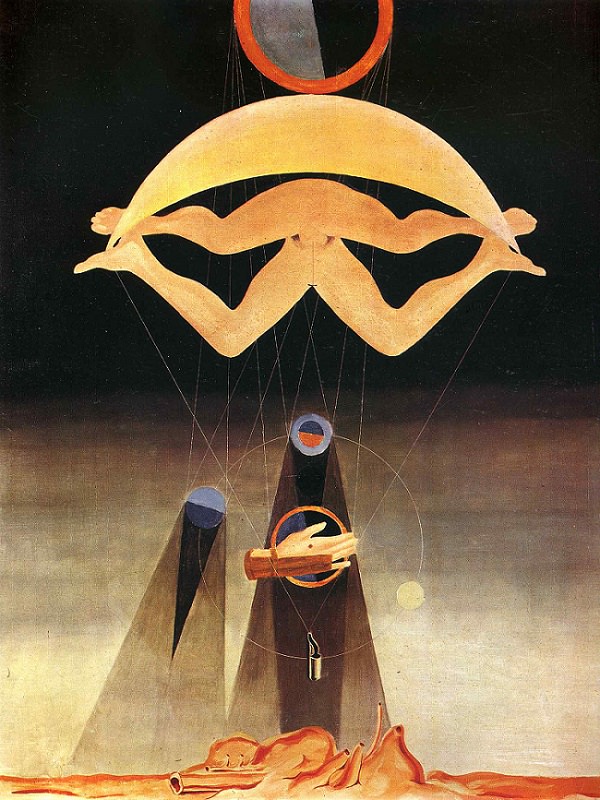The Single Image Narrative,
The lecture looks at what can be contained
within the single image, here accompanied by an extended text asttached
to the title.
1923
31" x 25"
Tate Gallery London.
Inscribed on the back
"LES HOMMES N'EN SAURONT RIEN
The crescent (yellow and parachutic) stops the little whistle falling
to the ground.
The whistle because people are taking notice of it, thinks it is climbing
to the sun.
The sun is divided into two so that it can spin better.
The model is stretched out in a dreaming pose. The right leg is bent
(a pleasant exact movement).
The hand hides the earth. Through this movement the earth takes on the
importance of a sexual organ.
The moon runs through its phases and eclipses with the utmost speed.
The picture is curious because of its symmetry."
and dedicated to Andre Breton. see also text associated with The Elephant
Celebes in Alley beneath.
b1891, hatched from an egg near Cologne.
1897 first contact with nothingness, , a vision of his father, "In
front of the panel, a shiny black man makes slow comic and according
to memories of a time long past, joyously obscene gestures. This odd
fellow wears my father's moustaches. After several leaps in slow motion
which revolt me, legs spread, knees folded, torso bent, he smiles and
takes from his pocket a big crayon made from some soft material which
I cannot more precisely describe. he sets to work. Breathing loudly,
he hastily traces black lines on the imitation mahogany. ..... Satisfied
with his art, the man seizes and gathers his creations into a kind of
a vase which for this purpose, he paints in the air. He whirls the contents
of the vase by moving his crayon faster and faster. The vase ends up
by spinning and becomes a top. The crayon becomes a whip. Now I realise
that this strange painter is my father. " (Max Ernst, Beyond Painting)
• 1913 first visit to Paris
• 1914- 1917 artillery engineer; the man with the head of iron,
hit by gun's recoil and a mule.
• 1918 associated with the DADA movement.
• 1919 first altered engravings
• 1922 moves to Paris, earns money in a souvenir factory. Early
work with the poet Paul Eluard.
• 1923-5, first major series of paintings, The Elephant of the
Celebes, Two Children Threatened by a Nightingale, Oedipus Rex, Revolution
by Night.
• 1925 discovery of frottage, rubbings.
Comparative Texts; from Schreber, beneath (see .Hinton also beneath);
That the malevolents stole his stomach, "Of the other internal
organs I will only mention the gullet and the intestines which were
torn or vanished repeatedly, further the pharynx, which I partly ate
up several times, finally the seminal cord against which very painful
miracles were directed, with the particular purpose of suppressing the
sensation of voluptuousness." "from this date [1894] the sending
forth of the sun's rays was taken over by God, more especially by the
lower God (Ariman); the voices that talk to me now identify him with
the sun. The upper God (Ormuzd) kept himself at a greater, even still
at a colossal distance ; I see his picture as a small sun-like disc..."
"I could cite here the names of hundreds if not thousands who,
as souls, trafficked with my nerves.... All these souls talked to me
as `voices', each unaware of the presence of the others. The ensuing
tumult in my head can be imagined......" from Canetti p.511
BOOKLIST
Max Ernst, Beyond Painting Wittenborn
Schultz New York 1948 (standard texts)
Ronald Alley, Catalogue of the Tate Collection ,
non-British artists, Tate/Sotheby Parke Bernet, London 1981
Geoffrey Hinton, "Max Ernst' Les Hommes ..." Burlington
Magazine , 1975 pp.292-299.
Charlotte Stokes, "The Scientific Methods of Max Ernst: His Use
of Scientific Subjects from La Nature", The Art Bulletin
, Sept.1980
Charlotte Stokes, The Equivocal Ernst: Some Sources and interpretations
of two Children..." Arts Magazine Jan.1983
Jeanne Segal, "Max Ernst's One Night of Love", Arts
Magazine Janury 1983. Related texts
Freud, The Interpretation of Dreams
Freud, Jokes and their Relation to the Unconscious various
editions
Freud, A Neurosis of Demoniacal Possession in the Seventeenth
Century [Christophe Haizman] 1923
D.P.Schreber, Memoirs of my Nervous Illness , translated
and edited by Ida Macalpine and Richard Hunter, intro by Samuel Weber,
Harvard Univ.Press London 1988
D.G.M.Schreber, Medical Indoor Gymnastics; or a System of
Hygenic Exercises for Home Use to be practiced Anywhere without Apparatus
or Assistance by Young and Old of Either Sex, for the Preservation
of Health and General Activity, 1909 32nd ed.
Elias Canetti, Crowds and Power , Penguin, Harmondsworth
1981 see Rulers and Paranoics.
|

